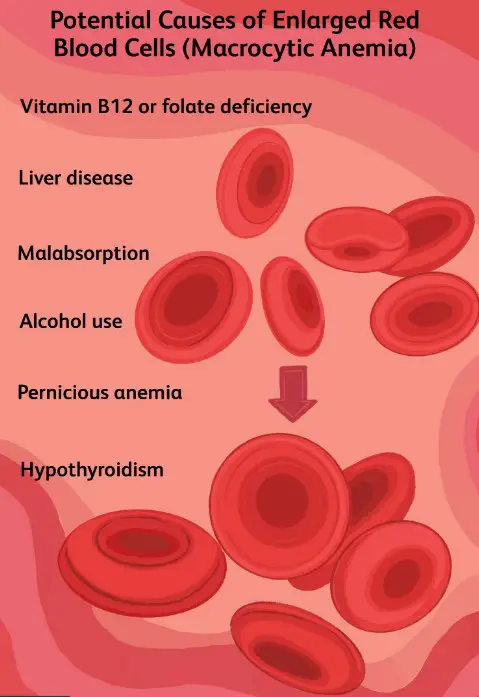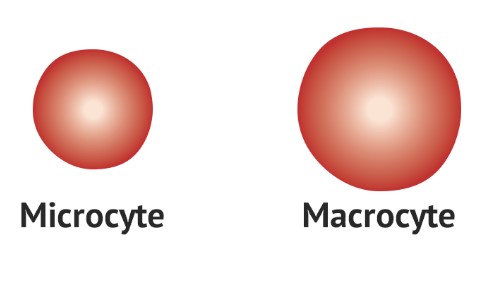Anemia is a prevalent condition characterized by a deficiency in the number or quality of red blood cells, which are crucial for transporting oxygen throughout the body. This deficiency can manifest as either microcytic or macrocytic anemia, each with distinct characteristics and implications for health. The distinction between these forms is primarily based on the size of red blood cells involved.
Microcytic anemia is marked by the presence of unusually small red blood cells, often linked to iron deficiency or chronic diseases, while macrocytic anemia features abnormally large red blood cells, typically caused by deficiencies in vitamin B12 or folate. The key to managing these conditions effectively lies in understanding their unique causes and the specific diagnostic and treatment strategies required for each.
Both types of anemia can significantly impact health, but they do so in different ways. Understanding the precise nature of the red blood cells involved is crucial for diagnosis and treatment. This distinction helps healthcare providers determine the underlying causes of anemia and the best approach to treatment, thereby improving patient outcomes.

Types of Anemia
Definition of Anemia
Anemia is a medical condition where the blood lacks enough healthy red blood cells or hemoglobin. Hemoglobin is vital because it helps carry oxygen from the lungs to the rest of the body. When someone has anemia, they often feel tired or weak because their body isn’t getting enough oxygen-rich blood.
Categories of Anemia
Anemia can be categorized based on the size of red blood cells or the cause behind the condition. The main types include:
- Microcytic Anemia: Small red blood cells.
- Macrocytic Anemia: Large red blood cells.
- Normocytic Anemia: Normal-sized red blood cells but reduced in number.
Each type points to different underlying causes and requires distinct diagnostic approaches and treatments.
Microcytic Anemia Explained
Definition and Overview
Microcytic anemia is characterized by red blood cells that are smaller than normal. This type of anemia often indicates issues with hemoglobin synthesis, which is typically due to iron deficiency or chronic diseases.
Common Causes
The most common causes of microcytic anemia include:
- Iron Deficiency: The most prevalent cause, often due to poor diet, blood loss, or increased iron needs.
- Chronic Diseases: Conditions like rheumatoid arthritis or tuberculosis can lead to microcytic anemia.
- Thalassemia: A genetic disorder affecting hemoglobin production.
Symptoms to Identify
Individuals with microcytic anemia may experience:
- Fatigue and weakness
- Pale skin
- Shortness of breath
- Cold hands and feet
Diagnosis Methods
Diagnosing microcytic anemia involves:
- Complete Blood Count (CBC): Measures the size and number of red blood cells.
- Iron Tests: Determine the levels of iron in the blood.
- Hemoglobin Electrophoresis: Used to detect thalassemia or other hemoglobin abnormalities.
Macrocytic Anemia Explained
Definition and Overview
Macrocytic anemia occurs when the red blood cells are larger than normal. This enlargement is usually linked to a deficiency in Vitamin B12 or folate which is crucial for DNA synthesis within the red blood cell development.
Common Causes
Key causes of macrocytic anemia include:
- Vitamin B12 Deficiency: Often due to poor diet, certain medications, or gut absorption issues.
- Folate Deficiency: Common in individuals with dietary deficiencies, especially where green leafy vegetables are scarce.
- Alcoholism: Can interfere with folate absorption.
Symptoms to Identify
Symptoms of macrocytic anemia can include:
- Fatigue
- Pale or jaundiced skin
- Cognitive difficulties
- Muscle weakness
Diagnosis Methods
To diagnose macrocytic anemia, the following tests are conducted:
- Complete Blood Count (CBC): Highlights larger red blood cells.
- Vitamin B12 and Folate Levels: Checks for deficiencies.
- Liver Function Test: To rule out liver impact.
Key Differences
Size of Red Blood Cells
- Microcytic Anemia: Smaller than normal red blood cells.
- Macrocytic Anemia: Larger than normal red blood cells.
Causes and Risk Factors
- Microcytic Anemia: Often caused by iron deficiency or chronic disease.
- Macrocytic Anemia: Typically results from deficiencies in Vitamin B12 or folate.
Impact on Health
- Microcytic Anemia: Can lead to severe fatigue and complications in pregnancy.
- Macrocytic Anemia: Associated with neurological complications and may indicate more severe health issues.

Diagnostic Approaches
Blood Tests and Their Importance
Blood tests play a crucial role in diagnosing anemia, providing vital information about the health and functionality of red blood cells. Key tests include:
- Complete Blood Count (CBC): Determines the concentration of red blood cells, white blood cells, and platelets. It also measures hemoglobin and hematocrit, providing insights into the size and volume of red blood cells.
- Iron Levels: Assess the amount of iron available for hemoglobin production, crucial for identifying iron-deficiency anemia.
- Ferritin Levels: Indicate the amount of stored iron in the body, helping to diagnose various forms of anemia.
These tests are essential for determining the type of anemia and guiding the treatment plan.
Advanced Diagnostic Tools
For more complex cases, advanced diagnostic tools may be employed:
- Bone Marrow Biopsy: Determines the health of bone marrow and its ability to produce red blood cells.
- Reticulocyte Count: Measures young red blood cells to assess bone marrow function.
- Genetic Testing: Useful in diagnosing hereditary conditions like thalassemia.
Treatment Strategies
Treatment for Microcytic Anemia
Treatment strategies for microcytic anemia typically focus on addressing iron deficiency:
- Iron Supplements: Oral iron supplements are the first-line treatment to replenish iron stores.
- Intravenous Iron: For cases where oral supplementation is ineffective or not possible.
- Dietary Changes: Increasing intake of iron-rich foods like red meat, beans, and fortified cereals.
Treatment for Macrocytic Anemia
Treatment for macrocytic anemia often involves correcting nutrient deficiencies:
- Vitamin B12 Injections: Used if the body cannot absorb B12 from food.
- Oral Folic Acid Supplements: To increase folate levels, especially important in pregnancy and chronic diseases.
- Adjusting Medications: Reviewing drugs that interfere with vitamin absorption.
Case Studies
Case Study on Microcytic Anemia
A 30-year-old female presented with fatigue and paleness. Lab tests showed low iron and ferritin levels, confirming iron-deficiency anemia. Treatment involved oral iron supplements and dietary adjustments. Over six months, her symptoms improved significantly, and blood tests returned to normal.
Case Study on Macrocytic Anemia
A 45-year-old male was experiencing memory issues and fatigue. Blood tests revealed low Vitamin B12 levels and large red blood cells. Intramuscular B12 injections were administered monthly, resulting in substantial improvement in symptoms and normalization of red blood cell size.
Managing Anemia
Lifestyle Adjustments
Managing anemia also involves lifestyle adjustments that can help mitigate symptoms and prevent recurrence:
- Regular Exercise: Enhances overall health and circulation.
- Adequate Sleep: Important for cellular repair and recovery.
- Stress Management: Reducing stress can improve immune function and overall health.
Diet and Nutrition Tips
Diet plays a critical role in managing and preventing anemia:
- Iron-Rich Foods: Include meats, beans, nuts, and fortified grains in the diet.
- Vitamin C-Rich Foods: Enhance iron absorption, so include fruits like oranges and strawberries.
- Limiting Alcohol: Alcohol can inhibit nutrient absorption and should be consumed in moderation.
Frequently Asked Questions
What is microcytic anemia?
Microcytic anemia occurs when the red blood cells are smaller than normal, typically due to iron deficiency. This condition can lead to symptoms like fatigue, pale skin, and general weakness, often prompting further investigation into iron levels and absorption.
What causes macrocytic anemia?
Macrocytic anemia is primarily caused by a deficiency in vitamin B12 or folate. These nutrients are essential for red blood cell production, and their lack leads to larger, underdeveloped red blood cells, which can cause symptoms such as fatigue, muscle weakness, and neurological issues.
How is anemia diagnosed?
Anemia is diagnosed using a complete blood count (CBC) test, which measures the size, number, and maturity of different blood cells. Specific tests to measure levels of iron, vitamin B12, and folate may also be conducted to determine the type of anemia.
What treatments are available for microcytic anemia?
Treatment for microcytic anemia typically involves iron supplementation to address iron deficiency. Dietary changes and treatment of underlying causes like gastrointestinal bleeding may also be necessary.
Can macrocytic anemia be cured?
Macrocytic anemia can often be treated effectively with supplements of vitamin B12 or folate if deficiencies are the cause. Addressing underlying health issues such as alcoholism or autoimmune disorders is also crucial for treatment success.
Conclusion
Understanding the difference between microcytic and macrocytic anemia is essential for effective diagnosis and management. These conditions, while both classified under anemia, demand distinct approaches due to their differing causes and effects on the body. Proper diagnosis, often involving a range of blood tests, is crucial to determine the specific type of anemia and the most appropriate treatment plan.
Timely and effective treatment can significantly improve the quality of life for those affected. Whether through dietary adjustments, supplementation, or addressing underlying health issues, managing anemia effectively requires a comprehensive understanding of its various forms and the factors that contribute to each.

